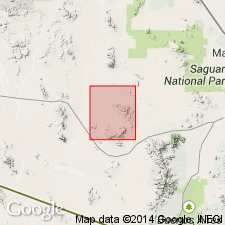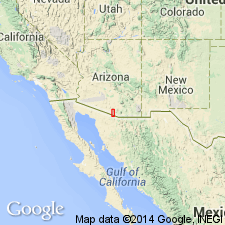
- Usage in publication:
-
- Sand Wells Formation*
- Modifications:
-
- Named
- Dominant lithology:
-
- Quartzite
- Mudstone
- Sandstone
- Arkose
- AAPG geologic province:
-
- Basin-and-Range province
Summary:
Named. Type locality is along the wash that passes along the south side of the village of Sand Wells, Pima Co, AZ in the Basin-and-Range province. Is made up mostly of gray quartzite, maroon mudstone, muddy sandstone, and gray-green arkose, but the basal unit is a massive red rhyolite flow capped by red conglomerate. The conglomerate is mostly fragments of pink to red rhyolite, and some quartz monzonite, and fragments of the Nolia, Cocoraque and Roadside Formations. At least 6,100 ft thick in south Comobabi Mountains. Weathers easily, best exposed along draws and washes. Overlies the newly named Nolia Volcanic Formation. Overlain by Tertiary volcanic rocks. Cut by mafic and felsic dikes, sills, and small plugs. Is Mesozoic. Geologic map.
Source: GNU records (USGS DDS-6; Denver GNULEX).

- Usage in publication:
-
- Sand Wells Formation*
- Modifications:
-
- Age modified
- AAPG geologic province:
-
- Basin-and-Range province
Summary:
Is assigned a Cretaceous? age.
Source: GNU records (USGS DDS-6; Denver GNULEX).

- Usage in publication:
-
- Sand Wells Formation*
- Modifications:
-
- Age modified
- AAPG geologic province:
-
- Basin-and-Range province
Summary:
Age is changed to Cretaceous or possibly Upper Jurassic.
Source: GNU records (USGS DDS-6; Denver GNULEX).
For more information, please contact Nancy Stamm, Geologic Names Committee Secretary.
Asterisk (*) indicates published by U.S. Geological Survey authors.
"No current usage" (†) implies that a name has been abandoned or has fallen into disuse. Former usage and, if known, replacement name given in parentheses ( ).
Slash (/) indicates name conflicts with nomenclatural guidelines (CSN, 1933; ACSN, 1961, 1970; NACSN, 1983, 2005, 2021). May be explained within brackets ([ ]).

